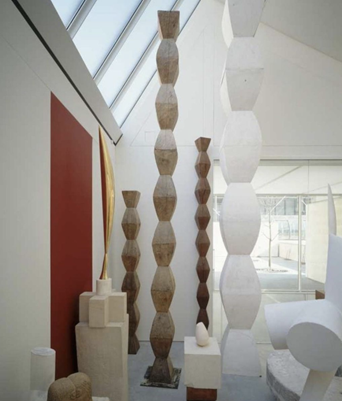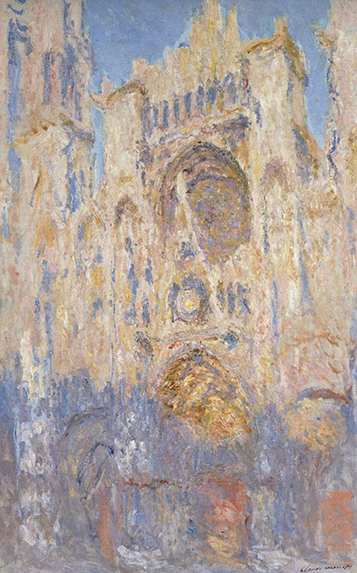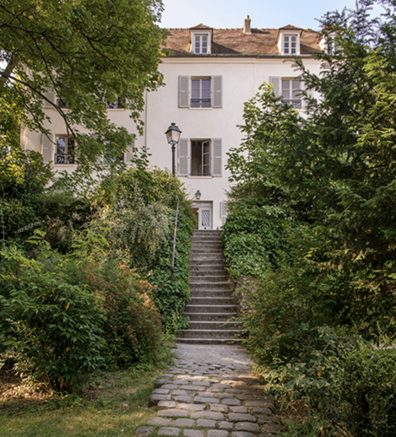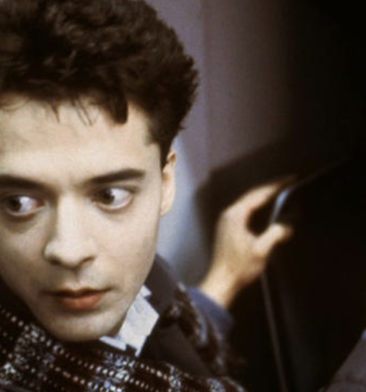1. ATELIER BRANCUSI
 Courtesy of the Atelier Brancusi Instagram account.
Courtesy of the Atelier Brancusi Instagram account.
This small, blink and you’ll miss it museum is located right in front of Centre Pompidou but is a world away from
the imperious, industrial yet curiously biological structure of the Pompidou. Layered with soft whites, creams, and
staunchly geometric shadows, that contrast with the sharp primary colors, concrete materials, and the simple shapes
of the atelier’s namessake’s sculptor, the Atelier Brancusi is a serene haven to encounter the invaluable work of
Constantin Brancusi.
55 Rue Rambuteau
75004, Paris
2. MUSÉE NATIONAL GUSTAVE MOREAU
 Courtesy of the Musée Gustave Moreau Instagram account.
Courtesy of the Musée Gustave Moreau Instagram account.
Perched innocuously on rue Catherine de la Rochefoucauld, on the way to the Opéra district and les grands magasins,
Musée National Gustave Moreau is dedicated to the eponymous symbolist artist from which the museum gets its name.
Following the artist’s decision in 1895 to open up the first floor of his home as an art museum to the public, the
Musée Gustaev Moreau has expanded to exhibit a variety of work from the artist’s multifaceted corpus including his
watercolors, sketches, and sculptures. Packed floor to ceiling with impossibly decadent paintings bustling with tiny
figures and motifs, that require multiple revisitations, the museum is a neo-classical treasure trove of extravagant
art that could only rival Peter Paul Rubens!
14 Rue Catherine de la Rochefoucauld
75009, Paris
3. MUSÉE MARMOTTAN MONET
 Courtesy of Musée Marmottan Monet.
Courtesy of Musée Marmottan Monet.
In a sleepy corner of the 16th Arrondissement, Musée Marmottan Monet is the perfect alternative to the
camera-clicking bustle of Musée de l’Orangerie. Home to a panoply of Claude Monet's most serene work including
smaller renditions of “Les Nymphéas,” that were recently displayed in the superb collaborative show,
“Monet/Mitchell,” at the Fondation Louis Vuitton, Musée Marmottan Monet highlights other iconic paintings of the
famed impressionist’s career, such as part of his “Rouen Cathedral” series, “Impression, Soleil Levant,” “En
Promenade Prés d’Argenteuil,” among many others.
The museum also includes quite a few women artists such as the painter whose paintings are to daily life as Virginia
Woolf is to literature, Berthe Morisot. Other featured artists encompass Jeanne Elisabeth Chaudet, Edouard Manet,
Marc Chagall, Paul Gauguin, Auguste Renoir, and an entire section of the museum dedicated to Medieval art up until
modernity. After enjoying this sublimely quiet and pastoral museum, head to Bois de Boulogne for an afternoon walk
or stroll the smaller park just outside the museum’s gate, the Jardin du Ranelagh, as mentioned in Joan Didion’s
poignant meditation on grief, The Year of Magical Thinking.
2 Rue Louis Boilly
75016, Paris
4. MUSÉE DE MONTMARTRE
 Courtesy of Musée Montmartre.
Courtesy of Musée Montmartre.
Ensconced behind a cold white façade that is generally unassuming, the florid and tranquil Musée de Montmartre is
brimming with history. Previously home to several resident artists, Émile Bernard, and Pierre Reverdy among others,
as well as Pierre Auguste Renoir, which is where he painted his internationally renowned pieces, “La Balançoire,”
(1876), and “Le Bal du Moulin de la Galette.” The museum contains a prestigious art collection featuring many
artists who populated the Montmartre area in pursuit of a bohemian lifestyle, such as Henri Toulouse Lautrec, whose
painting, “Le Moulin Rouge,” occupies a wall of the museum. Behind the building itself are the sprawling Renoir
gardens which incorporate the Café Renoir, the perfect place to pause and soak in the rich history presented by the
museum.
12 Rue Cortot
75018, Paris
5. CINÉMATHÈQUE FRANÇAISE
 Courtesy of la Cinématheque Française.
Courtesy of la Cinématheque Française.
Located in the often-overlooked 12th arrondissement, the Cinémathèque Française is a sure fire hit for any
cinephile! Take a tour of the Musée Méliès and discover the fascinating variety of prototypes that preceded the
first film camera, the first experiments with the possibilities of movie making, and props from some of cinema’s
finest offerings. If you have an hour or two to spare, explore the archives of the film library, or pop into the
movie theater located inside the Cinémathèque for a curated selection of movies and presentations by award winning
directors and film critics.
51 Rue de Bercy
75012, Paris
6. MUSÉE CURIE
 Courtesy of Trip Advisor.
Courtesy of Trip Advisor.
Whether your interests are in science, history, or pure curiosity, Musée Curie has something for everyone! Dedicated
to the work of Marie and Pierre Curie, as well as her oldest daughter and her husband, Iréne and Frederic
Joliot-Curie, and founded by their daughter Ève Curie, the museum has a poignant history as it consists of the
laboratories in which the Joliot-Curie couple discovered artificial radioactivity and Marie Curie conducted her
research until her death. Parts of the museum are entirely inaccessible on account of residual radioactivity but it
also maintains a meticulous archive pertaining to radioactivity and oncology in association with the Institut Curie.
1 Rue Pierre et Marie Curie
75005, Paris
7. FONDATION AZZEDINE ALAÏA
 Courtesy of Fondation Azzedine Alaia.
Courtesy of Fondation Azzedine Alaia.
Tucked away in the heart of le Marais, Fondation Azzedine Alaïa, houses a superb art collection of the
multi-disciplinary collector and internationally renowned fashion designer and couturier, the late Azzedine Alaïa.
Gorgeously styled influential pieces by the designer himself amidst photographs by some of the greats such as Peter
Lindbergh and Arthur Elgort, whose exhibitions in conjunction with Alaïa have shown at the museum respectively, such
as in the past expositions “Azzedine Alaïa, Peter Lindbergh,” “Alaïa and Balenciaga - Sculptors of Shape,” “Looking
for Oum Kulthum,” and currently on display, “Azzedine Alaïa, Arthur Elgort. Freedom.” Also attached are a bookshop
and café in which to relax after partaking in the divine collection.
18 Rue de la Verrerie
75004, Paris